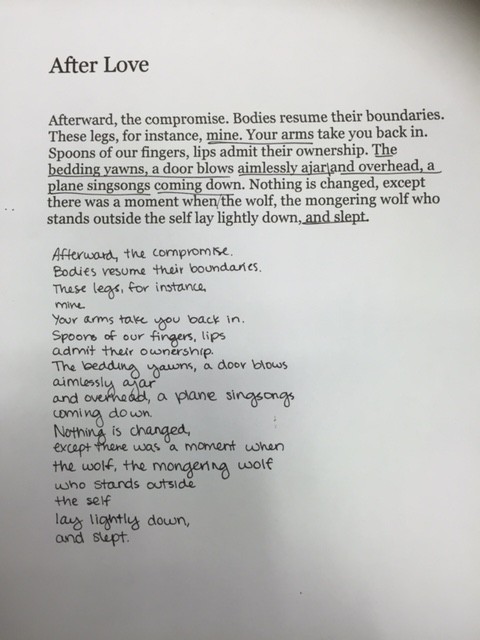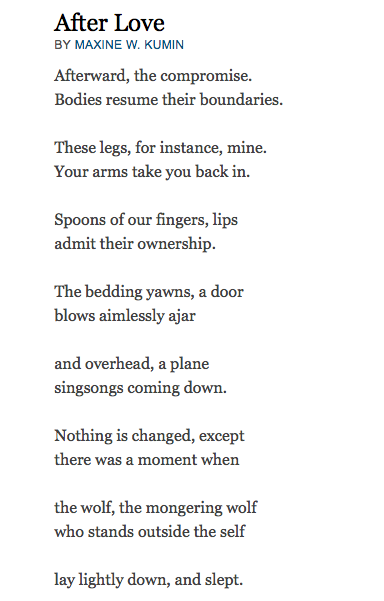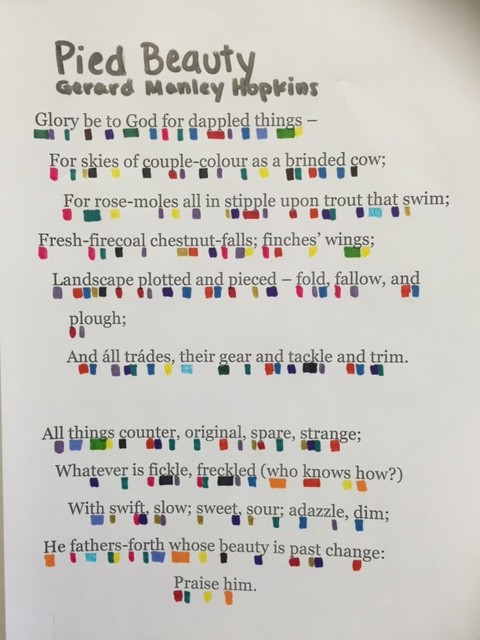Hi all!
I’ve only just gotten my account set up so I didn’t get a chance to post during 1st week.
Here’s a recap of some of the cool activities we did. One of the things I really enjoy about Jane as a professor is that she’s incorporating aspects of writing poetry into the class – so we’re not just analyzing other people’s poems; we’re also writing our own and doing other kinds of creative work.
For instance after spending time analyzing meter, we also talked about line breaks and how form contributes to the meaning of a work. Jane gave us a poem called “After Love.” She had collapsed into one paragraph with no formatting, and split us into groups of three to add line breaks and format the poem how we wished. The results were all unique poems that felt different to read – some starker and colder, more removed; others more conflicted or more hopeful. Then Jane gave us the poem formatted the way the poet chose: a series of couplets ending with a single line. None of our poems looked even remotely like the original. It was fascinating to see the effect form had on our interpretations of the poem. Here is the poem my group wrote, compared to the original:


On Wednesday we wrote our own sonnets in iambic pentameter and/or response poems in iambic tetrameter to Andrew Marvell’s “To His Coy Mistress” and read them aloud to the class on Thursday. Everyone took a different direction with each poem, and they were really fun to listen to.
On Friday we discussed sound in poetry and I got really into it. Maybe too into it, who knows. We catalogued sound patterns in Gerard Manley Hopkins’ “Pied Beauty,” noting the ways he uses sound to evoke images and colors within his written text. My partner for the activity, Jonathan, and I made this using a different color for each consonantal sound (though we didn’t get a chance to finish it completely). We tried to give softer consonants lighter colors and harder consonants darker colors when possible:
As we moved on to other poems in class, I couldn’t stop thinking about this poem, so naturally I distracted myself by color-coding the vowel sounds. Having just finished a Linguistics course, I have a solid knowledge of English phonology (meaning the study of sound in language). At its most basic there are 15 vowel sounds in English (12 pure vowels and 3 diphthongs), which is a lot more than most languages. Japanese, for instance, has only 5 pure vowels and no diphthongs. Spanish has 5 pure vowels and 5 diphthongs. I went through the “Pied Beauty” poem a second time, now in search of vowel patterns. This is what I produced:

Hopkins’ poem is pied indeed, full of many colors. So far it’s been a good class, and plenty fun working with Jane and my fellow classmates.
Over and out,
O